Frociaggine, Faggots & Faeries
Pope Francis says there's a lot of frociaggine in the Roman Catholic seminaries, a word which journalists are saying translates to “faggotry.” What is missing from the conversation is the root meaning, origin and history of these terms – here's a dip into that territory to show that these words, along with fairy/faerie, all conjure an ancient association between gay men, nature magic and the gods.
Lesbian writer Judy Grahn was telling us back in the early 1980s, in her book Another Mother Tongue, that “in the derogatory names faggot, queen, dyke, fairy... rest the remnants of ancient Gay tribal traditions: the social functions, offices and domains, the stories of origin and magical powers, of rebellious and sorcery, of witches, wizards, gods, spirits and shamanism, warriors and wars.”
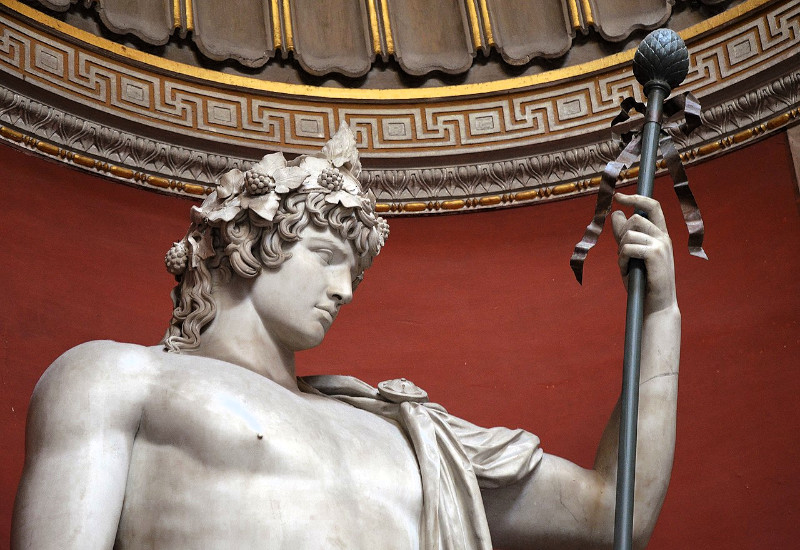 FROCIO - FINNOCHIO
FROCIO - FINNOCHIO
The Catholic Herald commented on the term used by the Pope, saying: “The root term in Italian is frocio, the most widely used pejorative term in Italian for a gay man, the etymology of which has been lost in time. (One theory traces it back to the 1527 sack of Rome, when feroci, or “ferocious”, invading troops supposedly raped men and women indistinctly, but nobody really knows.) The suffix -aggine denotes a quality or characteristic; for instance, Italians take the word stupido (which means what you think) and turn it into stupidaggini to convey acts of stupidity, i.e., 'nonsense.'”
However, queer writers have long had other ideas, and since the word Finnochio, meaning 'fennel', has long been an Italian word for gay men – it also seems shiningly obvious to me that Frocio is likely an abbreviated version of it.
Finnochio-fennel's association with gay men is due to the ancient world's most gender bending deity Dionysus, who held a wand or staff, known as a Thyrsus, made of a giant fennel stalk, and topped with a pine cone, an artichoke or more fennel. The thyrsus became a symbol used by followers of this God of wine, festivity, theatre and religious ecstasy.
Gay men were often the priests and channels of Dionysian spirit, leading rituals, instigating the dancing and love-making, bringing all sections of society together in holy orgiastic revelry – but this was seen as a threat to the stability and structure of society. Roman historian Livy recorded that the Bacchic rites were originally celebrated by women only, and in daylight – but shifted to nocturnal festivities which featured drunkenness, free mingling of the sexes and classes. He said the cult held particular appeal to those of uneducated and fickle mind (levitas animi), such as the young, plebeians, women and "men most like women", and that most of the city's population was involved, even some members of Rome's highest class. The Roman Senate tried to reform and control the rites with legislation in the year 186 BCE, but these rites were popular, and persisted throughout the Empire and after the rise of Christianity. Roman Emperor Theodosius (reigned 379-395 CE) prohibited all pagan worship, but three centuries later, in 692 the Quinisext Council in Constantinople was still warning Christians against participating in rural worship of Dionysus, specifically mentioning and prohibiting women's public dances and ritual crossdressing.
FAGGOT
Since faggotry is the term that English speakers are using as translation of frociaggine let's delve into the term, which has been so influential a word that 'fag' became the common term for cigarettes in the 20th century – a fag is a firestick. Also in the English public school system 'fagging' was, for centuries, as described by Judy Grahn, “the word used to describe the system of hazing, sexually abusing, and punishing schoolboys.” She considers this a “system developed by the Roman occupation.”
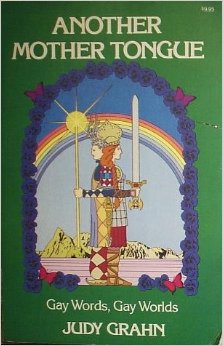 Judy Grahn explored the historical origins of slang terms for queer people in her 1982 book Another Mother Tongue. She wrote that:
Judy Grahn explored the historical origins of slang terms for queer people in her 1982 book Another Mother Tongue. She wrote that:
“The faggot is related to Gay wizardry, to wands and to the element of fire.”
“Finnochio and faggot are both very old terms referring to Gay men and to sacred fire as one and the same. They are references to the magical/creative powers specifically developed among the society of Gay males, both independently and with the 'fire' taken, stolen, or received as a gift from the female side of tribal society, especially through … women's priesthoods.”
Grahn gives the example of the enarees of Scythia, “a certain class of effeminate cross-dressed male priests,” described by Greek historian Herodotus around 400 BCE as using a technique of divination using bundles of willow sticks “which they say was taught them (at the temple of Aphrodite Urania) by Aphrodite.”
Arthur Evans, in Witchcraft and the Gay Counter-Culture (1978) put it like this:
“The history of the word 'faggot' reveals the intimate connection between gay men, heresy and witchcraft. Both witches and heretics were regularly burned on bundles of sticks called "faggots." In the popular speech of the time expressions popped up like "fire and faggot" or "to fry a faggot," suggesting that the victims themselves were called "faggots." "Faggot" even became "the embroidered figure of a faggot, which heretics who had recanted were obliged to wear on their sleeve, as an emblem of what they had merited." (Oxford English Dictionary). The word 'faggot' comes from the Latin fagus, which means beech tree. Fagus in turn derives from the Greek phagos or phegos, which originally meant any tree bearing edible nuts or fruit (in Greek, phagein means "to eat"). In classical Greek, phagos especially referred to oak trees. Burning witches and heretics on bundles of faggots may have originated from a religious link with trees (especially beech and oak)- which were sacred in pre-Christian Europe. The old fairy tree near Domremy where Joan of Arc first heard her voices was a fagus tree.”
During the Middle Ages the word faggot gained its negative twist, connected certainly with decrees and laws that demanded the death penalty, often by burning, for men who had sex with other men. This began in the late Roman Empire after the adoption of Christianity as the official religion - Emperor Theodosius issued an edict in 390 which quoted the Levitical prohibition on sex between men, and targeted male sexworkers, setting out to “punish all those whose criminal practice it is to condemn the male body to the submissiveness appropriate to the opposite sex.” It called for such men to be dragged out of the shameful male brothels and subjected to “avenging flames in the sight of the people.” Theodosius II issued a law code in 438 CE that repeated the edicts of 342 and 390, but omitted the reference to prostitution. “All persons who have the shameful custom of condemning a man’s body, acting the part of a woman’s… shall expiate the crime of this kind in avenging flames in the sight of the people.” Historian Louis Crompton points out that from this point onward the law “now clearly and unambiguously condemned all passive males to death by burning.” - a phrase that would reappear in the homophobic laws of the late Middle Ages. (Homosexuality and Civilisation, 2009).
During the witch-burning era (14-17th centuries), which drove “Europe's women out of power and their tribal traditions completely underground... sometimes to add to the horror and drive the lesson home further, the bodies of strangled Gay men were stacked in with the kindling at the witches' feet as 'faggots' of a new and horrible kind and as a sacrificial symbol turned upon the people who had valued living faggots, sacred Gay men.” (Judy Grahn)
Finnochios, frociaggines and faggots are actually nature's born priests for whom sex and ecstatic states are standard... and sacred. The suppression of gay love and sexuality was part of cutting the whole population off from the spirit world, and especially the Great Mother Goddess, who had been served by transgender and homoerotically inclined people since way back in time.
Harry Hay, a founder of the Radical Faeries said of queer folk:
“We have been a SEPARATE PEOPLE…. Drifting together in a parallel existence, not always conscious of each other.. yet recognising one another by eyelock when we did meet… here and there as outcasts… Spirit people… in service to the Great Mother.. Shamans.. mimes and rhapsodes, poets and playwrights, healers and nurturers… VISIONARIES… REBELS”
FAIRY/FAERIES
In the late 19th-early 20th century Fairy became a word commonly adopted by queer men and sometimes used by others to refer to them. There were connotations of a 'third-gender' about the term, which made it easier for straight-identified men to have sex with them without compromising their own sexual identity, than it has been since 'homosexual' became the normalised term from the 1950s.
'Gay New York : gender, urban culture, and the makings of the gay male world, 1890-1940', by George Chauncey (published 1994) reveals that a thriving, diverse and liberated queer subculture was growing in the USA up until the 1930s, when a more homophobic era sent queers into the closet until the end of the 1960s:
“By the 1890s gay men had made the Bowery a centre of gay life, and by the 1920s they had created three distinct gay neighbourhood enclaves in Greenwich Village, Harlem and Times Square, each with a different class and ethnic character, gay cultural style, and public reputation…. Tourists visited the Bowery, the Village and Harlem in part to view gay men’s haunts. In the early 1930s, at the height of popular fascination with gay culture, literally thousands of them attended the city’s drag balls to gawk at the drag queens on display there, while newspapers filled their pages with sketches of the most sensational gowns.
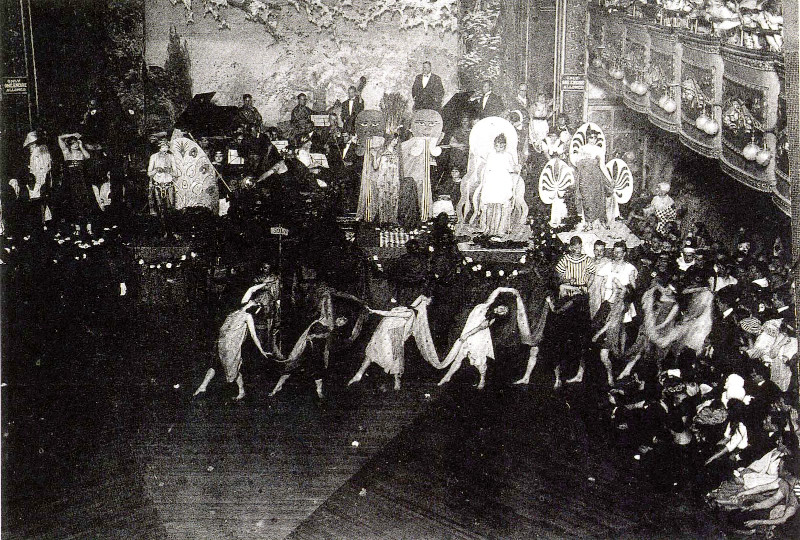 “The drag queens on parade and the effeminate homosexual men, usually called ‘fairies’, who managed to be flamboyant even in a suit were the most visible representatives of gay life…”
“The drag queens on parade and the effeminate homosexual men, usually called ‘fairies’, who managed to be flamboyant even in a suit were the most visible representatives of gay life…”
'On a Friday night in February 1926, a crowd of some 1,500 packed the Renaissance Casino in New York City’s Harlem neighborhood for the 58th masquerade and civil ball of Hamilton Lodge.
'Nearly half of those attending the event, reported the New York Age, appeared to be “men of the class generally known as ‘fairies,’ and many Bohemians from the Greenwich Village section who…in their gorgeous evening gowns, wigs and powdered faces were hard to distinguish from many of the women.”
'The tradition of masquerade and civil balls, more commonly known as drag balls, had begun back in 1869 within Hamilton Lodge, a black fraternal organization in Harlem. By the mid-1920s, at the height of the , they were attracting as many as 7,000 people of various races and social classes—gay, lesbian, bisexual, transgender and straight alike.'
https://www.history.com/news/gay-culture-roaring-twenties-prohibition
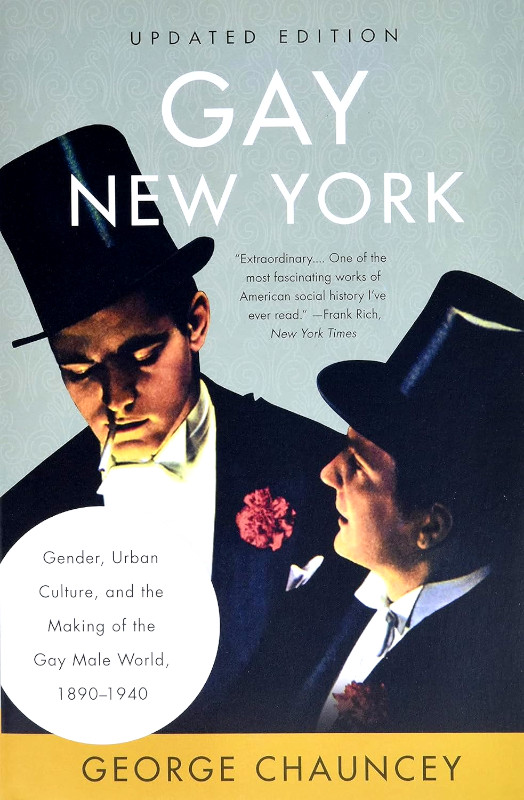
“Much evidence suggests that the fairy, so long as he abided by the conventions of this cultural script, was tolerated in much of working-class society… he was so obviously a ‘third-sexer’, a different species of human being, that his very effeminacy served to confirm rather than threaten the masculinity of other men… The fairies reaffirmed the conventions of gender even as they violated them: they behaved as no man should, but as any man might wish a woman would. Their representation of themselves as ‘intermediate types’ made it easier for men to interact with them (and even have sex with them) by making it clear who would play the ‘man’s part’ in the interaction.
“The men who adopted the styles of the fairy boldly announced to the world that they were sexually different from other omen and that they sexually desired other men. They made their existence obvious to everyone in the city and provoked a range of responses from ‘normal’ men: desire, contempt, fascination, abuse. Becoming a fairy offered men a way to make sense of their feeling sexually different from other men and to structure their relations with other men…. Some men who desired other men.. rejected the style and identity of the fairy altogether, but that style and identity had numerous meanings even to the men who embraced it. Some men.. identified with the image of the fairy completely; becoming a fairy seemed a ‘natural’ way to express their ‘true’ feminine natures…. Gay men themselves believed that such effeminacy was more natural to some men than to others.” 'Gay New York : gender, urban culture, and the makings of the gay male world, 1890-1940', by George Chauncey.
Spanish poet Federico Garcia Lorca referred to the 'fairies of North America' in his 1955 poem 'Ode to Walt Whitman' (alongside Pájaros (birds) of Havana, Jotos (jokers) of Mexico, Sarasas (chatterers) of Cádiz, Apios (celery — very similar to fennel) of Seville, Cancos (flowerpots) of Madrid, Floras (flowers) of Alicante and Adelaidas (soft nobility!) of Portugal, all of whom he was criticising for luring ‘doves’ ie young men into sexual underworlds, calling them “Sleepless enemies of the love that bestows crowns of joy.”)
The 1950s saw the emergence of a gay rights movement in the USA, of which one of the original activists, Harry Hay, would in later decades become a leading figure in the RADICAL FAERIE community. Faerie, like faggot and frociaggine, conjures the connection between gay people and nature. Radical is there to refer to a determination to get to the roots of our nature, of who we are in the world. Hay said: “When we begin to love and respect Great Mother Nature’s gift to us of gayness, we’ll discover that the bondage of our childhood and adolescence in the trials and tribulations of neitherness was actually an apprenticeship for teaching her children new cutting edges of consciousness and social change. In stunning paradox, our neitherness is our talisman, our fairie wand, our gift we bring to the hetero world to….transform their pain into healings; …transform their tears to laughter: …transform their hand-me-downs to visions of loveliness.”
Hay posited that by empathizing with all people, relating to each other as equal-to-equal, society would change drastically and social injustices would be eradicated. He saw gay people as born with this natural ability to engage ‘subject:SUBJECT’ consciousness in place.
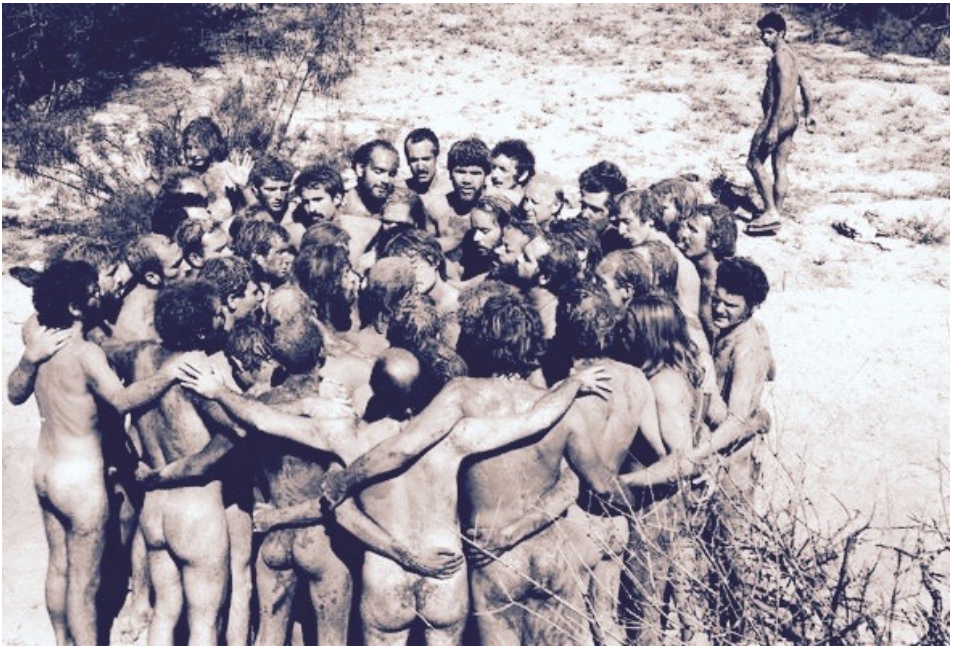
The first meeting of the now global Radical Faerie tribe of nature-loving, spiritual queers took place in Arizona in 1979. Following it 1979 Harry Hay wrote an article called ‘This New Planet of Faerie Vision…subject-SUBJECT consciousness’ in which he said:
“We must not suppose that we share subject-SUBJECT vision only in the spheres of Love and personal relations. Actually, almost at once, we also begin to become aware that we have been accumulating bits and pieces of subject-SUBJECT perceptions and insights all our lives – talking to trees and birds and rocks and Teddy Bears and remembering what all we had shared by putting it down in poetry, storing it all up for that wonderful day when we finally would flash on to what it all meant. The personal collecting and storing up of these secret treasures, these beautiful beckoning not-as-yet comprehensible secret sacra, is part of the hidden misery-cum-exaltation of growing up Gay. For the world we inherit, the total Hetero-Male-oriented-and-dominated world of Tradition and of daily environment, the summum bonum of our history, our philosophy, our psychology, our culture, and very languages of communication – all are totally subject – OBJECT in concept, in definition, in evolution, in self-serving orientation. Men and Women are – sexually, emotionally, and spiritually – objects to one another.
“Under the “fair-play-without-which-there-ain’t-no-game” rules of Hetero-Male aggressive territoriality, even the Hetero-Males- precisely because they conceive of themselves as in lifelong com- petition each with the others-engage themselves endlessly in tug-of-war games of Domination and Submission…
“To all of this we fairies should be, essentially, alien. Because those others with whom we seek to link, to engage, to slip into, to merge with are others like me, are SUBJECTS… like ME! I say “we fairies should be alien” to as many aspects of our Hetero-Male- dominated surroundings as we can be sensitive to, because we also know, all too glumly, just how easily and how often we fall prey to self-invited oppressions. How often do we allow ourselves, through fuzzy thinking, to accept or to identify with Hetero- originating definitions or misinterpretations of ourselves? The Hetero-male, incapable of conceiving that there could possibly be a window on the world other than his own, is equally incapable of perceiving that we Gay People might not fit in either of his Man/ Woman categories, that we might turn out to belong to quite other classifications. He might not be able to handle perceiving that the notion of all persons being only varying combinations of male and female is simply a Hetero-male-derived notion suitable only to Heteros and holding nothing of validity insofar as Gay people are concerned...
“Let us enter this brave new world of subject SUBJECT consciousness, this new planet of Fairy-vision…”
Many gay men have always been drawn, in every age, to spiritual service to the community. Our nature is spiritual, but was called sinful by religion. Scientific definitions of sexuality has furthered the forgetfulness of the spiritual purpose of gay people – but queers themselves have chosen other labels, such as the URANIANS of the late 19th century or the RADICAL FAERIES of the 20th, to reclaim the queer spirit. At the 1986 March on Washington Harry Hay “Brothers and Sisters, isn’t it about time we started to tell our parent Society who we really are? Isn’t it about time we helped them to understand that rather than being merely a sexual variation of them, in all other senses exactly the same of they, we are a Separate People with, in several measurable respects, a rather different window on the world, a different consciousness, which may be triggered into being by our lovely sexuality?”
Gay men have long been drawn to spiritual service, so it should be no wonder there are so many turning up in the seminaries. But no surprise the Pope is worried — froccagines and faggots are the continuing incarnation of ancient pagan holy powers, that threaten the moralistic, patriarchal, judgemental doctrines of official Christianity.
But where else can those drawn to sacred service fulfil that calling? Historically, throughout all cultures of the world, same-sex loving people, and gender-fluid folk, have served as shamans, in temples, as gatekeepers, as the Dagara tribe of Western Africa calls us. Christian priests continue the cross-dressing of the pagan holy men, but tried for many centuries to prevent the rest of the population engaging in the spiritual process and power that transvestism, and homoeroticism, can bring.
The Church also tried to prevent its own priests from pursuing their own homoerotic desires – with little success! In the Middle Ages the Catholic monasteries and the Church in general were sanctuaries for same-sex attracted people, which Benedictine monk Peter Damien complained about in The Book of Gomorrah, in 1051 CE – he objected fiercely to clerics indulging in practices of solitary masturbation, mutual masturbation, copulation between the thighs, anal copulation, and objected to priests having sexual relationships with adolescent boys. He opposed the ordination of anyone who engaged in homosexual sex and wanted those already ordained dismissed from Holy Orders. How little things have changed it seems!
Let me sum it up again:
Finnochios, frociaggines and faggots are actually nature’s born priests for whom sex and ecstatic states are standard — are sacred — and are a technique of connecting the human and spirit worlds. The suppression of gay love and sexuality was part of cutting the whole population off from the spirit world, and especially the Great Mother Goddess, who had been served by transgender and homoerotically inclined people since way back in time. The continued refusal to see all consensual loving relationships between adults as equal is holding back the world’s reconnection to her infinite, unconditionally loving, creative, cosmic presence.
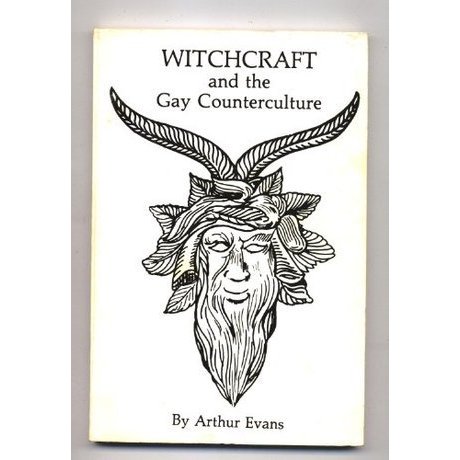
“We look forward to creating a genuine Gay culture, one that is free from exploitation by bars, baths, and gay business owners. We look forward to re-establishing women’s mysteries and men’s mysteries as the highest expression of collective Gay culture and sexuality. We look forward to regaining our ancient historical roles as medicine people, healers, prophets, shamans and sorcerers. We look forward to an endless and fathomless process of coming out — as gay people, as animals, as humans, as mysterious and powerful spirits that move through the life cycle of the cosmos….. Like butterflies we are emerging from the shells of our past restricted existence. We are re-discovering the ancient magic that was once the birth right of all human beings. We are re-learning how to talk to the worms and the stars. We are taking flight on the wings of self-determination. Come, blessed Lady of the Flowers, Queen of Heaven, creator and destroyer, Kali — we are dancing the dance of your coming.” Arthur Evans.



